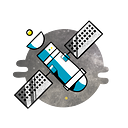
How could the EDUCATION sector harness blockchain?
Written by @ColorReader, Edited by @RealScrout
Blockchain’s possible effects on education:
With blockchain technology taking centre stage in media, public interest has increased on what this technological innovation may bring to the table. Many are naturally optimistic regarding its usage in different sectors, such as insurance[1], banking and education. In this Medium, we will be looking at the latter.

What is a blockchain, and how does it operate?
There are many in-depth articles available on what a blockchain is, and we recommend reading up on its fundamentals before reading on. In short, it is a distributed ledger, which keeps information stored on-chain. This information can vary with use, ranging from public records, medical data[3] to media ownership through Non-Fungible Tokens (NFTs).
Decentralized, digital nodes make sure this information is verifiably correct and does not have a single point of failure. This alone puts blockchain ahead of centralized information storage and is one of the advantages that sets it apart from the current standard. Couple this with smart contracts[4], and you have a technological solution that can be trustless, efficient and robust.
Verifiable grades, books and student information
Currently, employers and educational institutions rely on paper and digital copies of credentials. These digital copies can be forged, and therefore pose a risk to said parties. Having diplomas, grades, and other student documents permanently verifiable is a way to avoid the possibilities of forgery is a significant advantage blockchain implementation can bring.
The same benefits can be applied to textbooks and other works; verifying the sources of studies only published digitally can become more accessible than it currently is. Access points to such become less vulnerable to data loss than relying on centralised servers and databases.
Bundled NFTs as certificates
The NFT space has rapidly evolved in the last year, focusing on artwork, music, and other forms of media. However, these tokens can also be used as digital certificates of skills, finished courses etc.
Some projects, such as 0xmons, are exploring the possibilities of cheap and orderly bundling of NFTs[5]. Although bundling is currently in the early experimental stages, it perfectly highlights a largely unutilised code feature. Having a single NFT bundled with all necessary documents streamlines the review process for employers and interviewers and effectively removes risks of illegitimacy.

Incentives, DAOs and early exposure
Diligent schoolwork has a plethora of longer-term benefits as-is, but what if we further incentivized it through additional rewards within the school system? The arrival of Decentralized, Autonomous Organizations [7] (or DAOs, for short) opens the door for self-governed platforms and decision-making.
Proposals and votes are made and concluded with the help of governance tokens. These tokens can be given to students showing good behaviour and could help “gamify” student councils and contributions. School DAOs also open up for a lower barrier of entry for participants, making it an all-online experience quickly processed with a few clicks. Introducing DAOs, smart contracts and blockchain early on also makes the technology familiar to students. This familiarity would make it easier for the next generations to be a few steps ahead in a rapidly evolving digital age. And because of its seamless integration, the ones disinterested will not be obligated to understand it on a technical level to use it fully, a testament to accessibility when adequately implemented.

When can we expect all of this?
When it comes to a time estimate for implementing this technology, there is good news and bad news. The good news is that the resurgence of attention to the crypto space will lead to discovery; many qualified professionals are being exposed to this technology and some show interest in contributing. This will speed up development. The bad news is that the technology is still very early; regulations and audits are necessary for mainstream usage. As such, it is hard to provide any ETA for any sorts of implementations. Luckily, the space is continually growing. Gradual testing and implementation is a good course of action and is the direction crypto is currently headed.
Website: www.lunarstation.io
Telegram: https://t.me/lunarstation
Twitter: https://twitter.com/lunarstation_
References:
[1] RealScrouter (2021). How could the insurance sector harness blockchain? [online] Medium. Available at: https://lunarstation.medium.com/how-could-the-insurance-sector-harness-blockchain-c787ac97fd16 [Accessed 24 Apr. 2021].
[2] CBInsights (2020). Decentralised Ledger. https://www.cbinsights.com/research/what-is-blockchain-technology/. Available at: https://research-assets.cbinsights.com/2020/08/18154024/112017-Blockchain-4-V2-1024x570.png [Accessed 24 Apr. 2021].
[3] Dentacoin: The Blockchain Solution for the Global Dental Industry WHITEPAPER v.2.2. (n.d.). [online] . Available at: https://dentacoin.com/assets/uploads/whitepaper.pdf [Accessed 24 Apr. 2021].
[4] www.ibm.com. (n.d.). What are smart contracts on blockchain? [online] Available at: https://www.ibm.com/topics/smart-contracts [Accessed 24 Apr. 2021].
[5] Owen (2021). 0xmons v2 Cthulhu: On-chain Encoding. [online] blog.0xmons.xyz. Available at: https://blog.0xmons.xyz/79081566310 [Accessed 24 Apr. 2021].
[6] Subsocial Network (2020). DAO. https://app.subsocial.network/@uniqueone/unique-one-dao-proposal-for-governance-structure-494. Available at: https://miro.medium.com/max/1400/1*p2Bh4P3Yu5unaKPLVg5srw.png [Accessed 24 Apr. 2021].
[7] Cointelegraph. (n.d.). What is DAO and how it works. [online] Available at: https://cointelegraph.com/ethereum-for-beginners/what-is-dao [Accessed 24 Apr. 2021].

